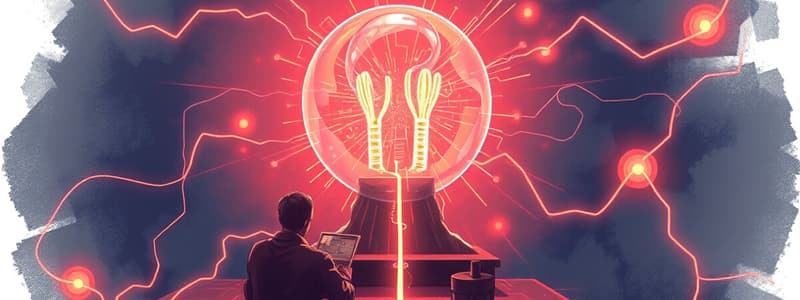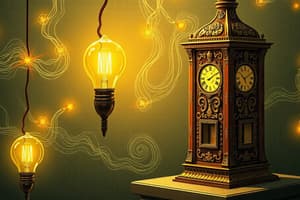Podcast
Questions and Answers
What is the formula that describes the relationship between voltage, current, and resistance?
What is the formula that describes the relationship between voltage, current, and resistance?
Which of the following correctly defines resistance?
Which of the following correctly defines resistance?
In a series circuit, what happens if one component fails?
In a series circuit, what happens if one component fails?
Which type of current flows in one direction only?
Which type of current flows in one direction only?
Signup and view all the answers
What is the purpose of a capacitor in an electrical circuit?
What is the purpose of a capacitor in an electrical circuit?
Signup and view all the answers
Which component is used to visualize electrical signals over time?
Which component is used to visualize electrical signals over time?
Signup and view all the answers
What is the purpose of high-voltage power lines in power transmission?
What is the purpose of high-voltage power lines in power transmission?
Signup and view all the answers
How is electrical resistance measured?
How is electrical resistance measured?
Signup and view all the answers
Study Notes
Basics of Electricity
- Definition: Flow of electric charge, primarily carried by electrons.
-
Units:
- Voltage (V): Potential difference, measured in volts.
- Current (I): Flow of electric charge, measured in amperes (A).
- Resistance (R): Opposition to current, measured in ohms (Ω).
- Power (P): Rate of doing work or energy conversion, measured in watts (W).
Ohm's Law
- Formula: V = I × R
- Describes the relationship between voltage, current, and resistance.
- Applicable to resistive circuits.
Circuit Types
-
Series Circuits:
- Components connected end-to-end.
- Same current flows through all components.
- Total resistance: R_total = R1 + R2 + R3 + ...
- If one component fails, the entire circuit breaks.
-
Parallel Circuits:
- Components connected across common points.
- Same voltage across all components.
- Total resistance: 1/R_total = 1/R1 + 1/R2 + 1/R3 + ...
- If one component fails, others remain functional.
Key Components
- Resistors: Limit current flow and adjust voltage levels.
- Capacitors: Store and release electrical energy.
- Inductors: Store energy in a magnetic field when electric current flows through them.
- Diodes: Allow current to flow in one direction only.
- Transistors: Act as switches or amplifiers in circuits.
AC vs DC
-
Alternating Current (AC):
- Current changes direction periodically.
- Commonly used for power supply.
- Frequency measured in hertz (Hz).
-
Direct Current (DC):
- Current flows in one direction.
- Found in batteries and electronic devices.
Electrical Safety
- Always use equipment rated for the voltage and current involved.
- Understand the risks of electric shock and fire.
- Use proper insulation and grounding techniques.
- Follow safety protocols when working with electricity.
Power Generation and Distribution
-
Sources:
- Fossil fuels, nuclear, solar, wind, and hydroelectric.
-
Transmission:
- High-voltage power lines reduce energy loss over distances.
-
Distribution:
- Voltage is stepped down for safe use in homes and businesses.
Electrical Measurements
- Multimeter: Measures voltage, current, and resistance.
- Oscilloscope: Visualizes electrical signals over time.
Electromagnetism
- Relationship between electricity and magnetism.
- Moving electric charges create magnetic fields.
- Change in magnetic field can induce electric current (Faraday's Law).
Common Electrical Formulas
- Power: P = V × I
- Energy: E = P × t (where t is time in hours)
- Electrical Work: W = V × Q (where Q is charge in coulombs)
Basics of Electricity
- Electricity is the flow of electric charge, primarily involving the movement of electrons.
- Key units in electricity include:
- Voltage (V): Potential difference between two points, measured in volts.
- Current (I): The flow of electric charge, quantified in amperes (A).
- Resistance (R): The opposition encountered by current, expressed in ohms (Ω).
- Power (P): The rate of energy conversion or work done, measured in watts (W).
Ohm's Law
- Ohm's Law is expressed by the formula V = I × R.
- It illustrates the relationship between voltage, current, and resistance in resistive circuits.
Circuit Types
-
Series Circuits:
- Components are connected in a sequence, causing the same current to flow through all parts.
- Total resistance is the sum of individual resistances: R_total = R1 + R2 + R3 +...
- A failure in any single component results in the entire circuit becoming inoperative.
-
Parallel Circuits:
- Components are connected across identical voltage sources.
- The same voltage is applied to all components.
- Total resistance can be calculated using: 1/R_total = 1/R1 + 1/R2 + 1/R3 +...
- If one component fails, others remain functional and the circuit continues to operate.
Key Components
- Resistors: Devices used to limit the flow of current and control voltage levels in a circuit.
- Capacitors: Components that can store electrical energy temporarily and release it when needed.
- Inductors: Components that store energy within a magnetic field generated by electric current.
- Diodes: Semiconductor devices that allow current flow in one direction only, preventing backflow.
- Transistors: Versatile devices that function as switches or amplifiers, crucial for modern electronics.
AC vs DC
-
Alternating Current (AC):
- The current periodically changes direction, making it suitable for powering electric utilities.
- Frequency of AC is measured in hertz (Hz).
-
Direct Current (DC):
- The current flows consistently in one direction.
- Commonly found in batteries and many electronic devices.
Electrical Safety
- Use equipment rated for the specific voltage and current to prevent hazards.
- Awareness of electric shock and fire risks is crucial for safety.
- Employ proper insulation and grounding techniques during electrical work.
- Adhere strictly to safety protocols to safeguard against accidents.
Power Generation and Distribution
- Electricity can be generated from various sources including fossil fuels, nuclear, solar, wind, and hydroelectric power.
- High-voltage power lines are used for transmission to minimize energy loss during long-distance travel.
- Voltage is reduced for safe and practical use in residential and commercial settings through a distribution process.
Electrical Measurements
- A Multimeter is an essential tool that measures voltage, current, and resistance.
- An Oscilloscope visually represents electrical signals over time, allowing for detailed analysis.
Electromagnetism
- There is an intrinsic link between electricity and magnetism; moving electric charges produce magnetic fields.
- Changes in magnetic fields can induce electric current, as stated in Faraday's Law.
Common Electrical Formulas
- Power calculation: P = V × I.
- Energy consumption over time: E = P × t (where t is time in hours).
- Calculation of electrical work: W = V × Q (where Q is the quantity of charge in coulombs).
Studying That Suits You
Use AI to generate personalized quizzes and flashcards to suit your learning preferences.
Description
Test your understanding of the fundamental concepts of electricity, including the definitions and units of voltage, current, resistance, and power. This quiz covers Ohm's Law and the characteristics of series and parallel circuits. Perfect for students learning electrical principles.




